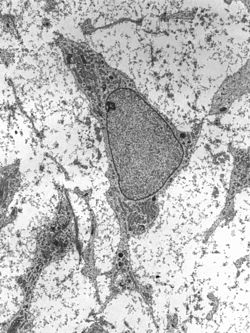Stem Cell Research
| Stem cell | |
|---|---|

Transmission electron micrograph of an adult stem cell displaying typical ultrastructural characteristics.
|
|
| Details | |
| Identifiers | |
| Latin | Cellula praecursoria |
| Code | TH H2.00.01.0.00001 |
| TH | H1.00.01.0.00028, H2.00.01.0.00001 |
| FMA | 63368 |
|
Anatomical terminology
[]
|
|
Stem cells are undifferentiated biological cells that can differentiate into specialized cells and can divide (through mitosis) to produce more stem cells. They are found in multicellular organisms. In mammals, there are two broad types of stem cells: embryonic stem cells, which are isolated from the inner cell mass of , and adult stem cells, which are found in various tissues. In adult organisms, stem cells and progenitor cells act as a repair system for the body, replenishing adult tissues. In a developing embryo, stem cells can differentiate into all the specialized cells—ectoderm, endoderm and mesoderm (see induced pluripotent stem cells)—but also maintain the normal turnover of regenerative organs, such as blood, skin, or intestinal tissues.
There are three known accessible sources of autologous adult stem cells in humans:
Stem cells can also be taken from umbilical cord blood just after birth. Of all stem cell types, autologous harvesting involves the least risk. By definition, autologous cells are obtained from one's own body, just as one may bank his or her own blood for elective surgical procedures.
Adult stem cells are frequently used in various medical therapies (e.g., bone marrow transplantation). Stem cells can now be artificially grown and transformed (differentiated) into specialized cell types with characteristics consistent with cells of various tissues such as muscles or nerves. Embryonic cell lines and autologous embryonic stem cells generated through somatic cell nuclear transfer or dedifferentiation have also been proposed as promising candidates for future therapies. Research into stem cells grew out of findings by Ernest A. McCulloch and James E. Till at the University of Toronto in the 1960s.
...
Wikipedia
